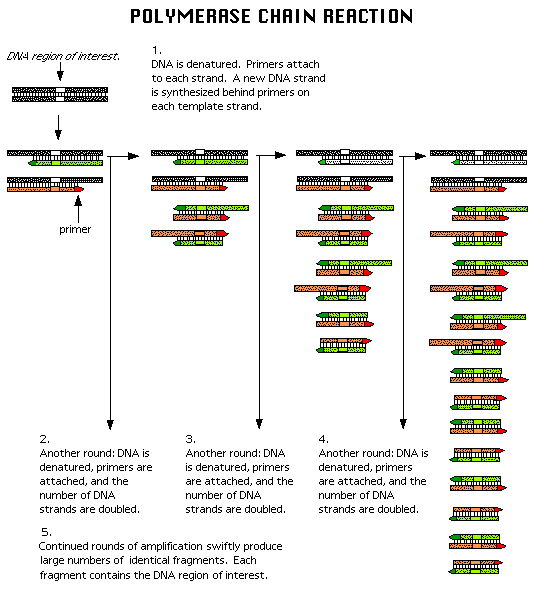Polymerase Chain Reaction - Xeroxing DNA

The elegant technique of PCR, by which fragments of DNA can be made to replicate very rapidly, is illustrated.
Figure Legend:
Polymerase chain reaction (PCR), is a common method of creating copies of specific fragments of DNA. PCR rapidly amplifies a single DNA molecule into many billions of molecules.
In one application of the technology, small
samples of DNA, such as those found in a strand of hair at a crime scene,
can produce sufficient copies to carry out forensic tests.
Who would have thought a bacterium hanging out in a hot spring in Yellowstone National Park would spark a revolutionary new laboratory technique? The polymerase chain reaction, now widely used in research laboratories and doctor's offices, relies on the ability of DNA-copying enzymes to remain stable at high temperatures. No problem for Thermus aquaticus, the sultry bacterium from Yellowstone that now helps scientists produce millions of copies of a single DNA segment in a matter of hours.
In nature, most organisms copy their DNA in the same way. The PCR mimics this process, only it does it in a test tube. When any cell divides, enzymes called polymerases make a copy of all the DNA in each chromosome. The first step in this process is to "unzip" the two DNA chains of the double helix. As the two strands separate, DNA polymerase makes a copy using each strand as a template.
The four nucleotide bases, the building blocks of every piece of DNA, are represented by the letters A, C, G, and T, which stand for their chemical names: adenine, cytosine, guanine, and thymine. The A on one strand always pairs with the T on the other, whereas C always pairs with G. The two strands are said to be complementary to each other.
To copy DNA, polymerase requires two other components: a supply of the four nucleotide bases and something called a primer. DNA polymerases, whether from humans, bacteria, or viruses, cannot copy a chain of DNA without a short sequence of nucleotides to "prime" the process, or get it started. So the cell has another enzyme called a primase that actually makes the first few nucleotides of the copy. This stretch of DNA is called a primer. Once the primer is made, the polymerase can take over making the rest of the new chain.
A PCR vial contains all the necessary components for DNA duplication: a piece of DNA, large quantities of the four nucleotides, large quantities of the primer sequence, and DNA polymerase. The polymerase is the Taq polymerase, named for Thermus aquaticus, from which it was isolated.
The three parts of the polymerase chain reaction are carried out in the same vial, but at different temperatures. The first part of the process separates the two DNA chains in the double helix. This is done simply by heating the vial to 90-95 degrees centigrade (about 165 degrees Fahrenheit) for 30 seconds.
But the primers cannot bind to the DNA strands at such a high temperature, so the vial is cooled to 55 decrees C (about 100 degrees F). At this temperature, the primers bind or "anneal" to the ends of the DNA strands. This takes about 20 seconds.
The final step of the reaction is to make a complete copy of the templates. Since the Taq polymerase works best at around 75 degrees C (the temperature of the hot springs where the bacterium was discovered), the temperature of the vial is raised.
The Taq polymerase begins adding nucleotides to the primer and eventually makes a complementary copy of the template. If the template contains an A nucleotide, the enzyme adds on a T nucleotide to the primer. If the template contains a G, it adds a C to the new chain, and so on to the end of the DNA strand. This completes one PCR cycle.
The three steps in the polymerase chain reaction - the separation of the strands, annealing the primer to the template, and the synthesis of new strands - take less than two minutes. Each is carried out in the same vial. At the end of a cycle, each piece of DNA in the vial has been duplicated.
But the cycle can be repeated 30 or more times. Each newly synthesized DNA piece can act as a new template, so after 30 cycles, 1 million copies of a single piece of DNA can be produced! Taking into account the time it takes to change the temperature of the reaction vial, 1 million copies can be ready in about three hours.
PCR is valuable to researchers because it allows them to multiply unique regions of DNA so they can be detected in large genomes. Researchers in the Human Genome Project are using PCR to look for markers in cloned DNA segments and to order DNA fragments in libraries.
National Center for Human
Genome Research, National Institutes of Health. "New Tools for Tomorrow's
Health Research." Bethesda, MD: Department of Health and Human Services,
1992.